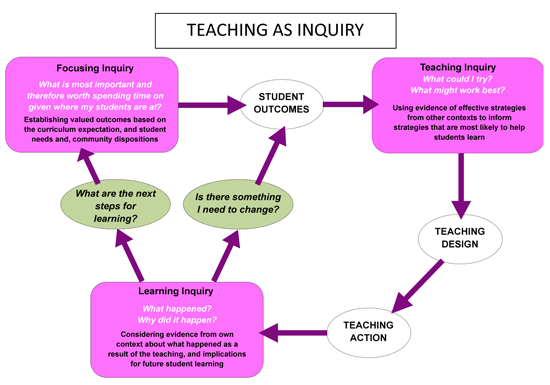Base your teaching on inquiry
The teaching as inquiry model provides an evidenced based framework for developing engaging programmes of learning that spark the curiosity of students.
There is no particular starting or ending point of the inquiry. It’s a cyclical process.
Economics teachers who are preparing new senior courses will probably begin with the focusing inquiry.

Teaching as inquiry diagram
Teachers need to be constantly asking themselves:
- where their students are in their learning
- how they can help them progress
- how their teaching impacts on the students’ learning.
Use this information to decide:
- What should I teach next? (focusing inquiry)
- How should I teach it? (teaching inquiry)
- What do I base those decisions on? (learning inquiry)
The programme needs to have enough flexibility to ensure student interests can be accommodated.
TOP
Inquiry as a process – a possible approach
Planning – beginning
- What do I know about each student’s prior knowledge, goals and aspirations, and learning strengths and needs?
- What is important and worth spending time on?
- What economic concepts, big ideas, and academic vocabulary need to be introduced or reinforced?
- What contexts might help my students discover and explore these big ideas?
Delivery – during
- How can I teach my next lesson most effectively?
- What learning tasks and approaches are most likely to help my students to progress?
- What formative assessment methods can I use to monitor student progress and understanding, for example, quizzes, short answer questions, source interpretation, or word lists?
Something I need to change about how I teach?
- Do I engage students with the context or the material effectively?
- Do I maintain dialogue with students and encourage dialogue between students throughout the learning process?
- Do I recognise and accommodate the diverse learning needs of all my students, for example, by incorporating tikanga Māori into my teaching?
- How can I involve families, community, and whānau in my teaching?
Reflection – after
- What happened as a result of the teaching?
- Did my students achieve the specified outcomes?
- What are the implications for future teaching?
Application – next steps
- What are the next steps for my students’ learning?
- What concepts/big ideas need to be reinforced or introduced next?
- What different contexts might my students need to discover and explore these big ideas?
- How can I use student feedback to improve or modify planning, delivery, and outcomes for future learning?
< back to pedagogy
Last updated March 21, 2012
TOP


